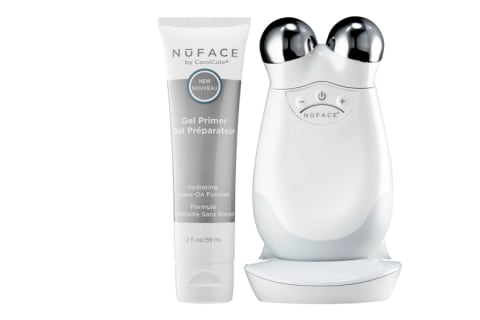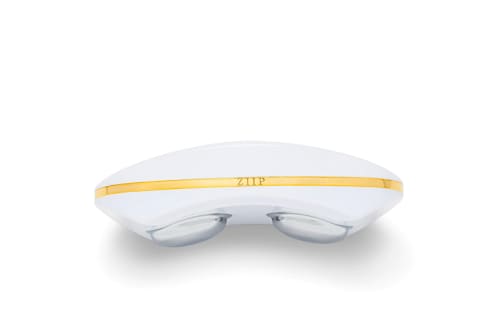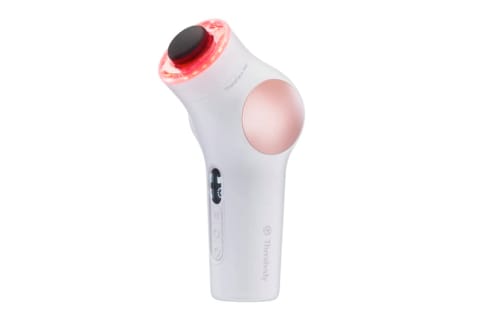Advertisement
Everything You Need To Know Before Booking A Microcurrent Facial

I'll never forget my first microcurrent facial. I didn't know what to expect—does it hurt? Would I feel any shocks? What's with the ultrasound-like gel?—but I was practically giddy with the outcome. After floating the tingly probes across half of my face, my esthetician held up a mirror so I could compare my side-by-side results: My right side appeared noticeably more lifted and toned, particularly near the cheekbones and jawline. Consider me hooked.
Would you consider the magic of microcurrent? Ahead, find everything you need to know before booking a treatment, including the very sciencey reason it helps your facial muscles act younger.
What is a microcurrent facial?
Essentially, a microcurrent facial is like strength training for your skin. "It stimulates the facial muscles underneath the skin, which will help to improve the facial contour, tone the skin, and reduce wrinkles," says celebrity esthetician Shani Darden. An esthetician will use a handheld electromagnetic device that sends gentle jolts of energy to stimulate your skin cells—this, in turn, can "exercise" the facial muscles and make them appear more toned and lifted.
It all has to do with a molecule called adenosine triphosphate (ATP), which acts as your body's natural energy currency. "What we do with microcurrent is replenish and boost the ATP and therefore, the collagen and elastin," biomedical engineer and holistic skin care expert Pooja Johari, M.S., says in an episode of Clean Beauty School.
Now, some spa menus might include microcurrent in "firming" or "sculpting" facials, along with other vibration therapy tools (like Darden's Facial Sculpting Wand) and face massage techniques. But unlike lymphatic drainage facials, which activate your body's natural detoxification process, microcurrent uses electrical energy to stimulate the skin. "So it's more precise and targeted, resulting in a higher stimulation of collagen and elastin cells than traditional methods," says Frankie Garcia, esthetician at Face Haus.
Benefits.
Here's what you can expect from a microcurrent treatment:
- Sculpts & tightens the skin: "Microcurrent facials are safe for all but most beneficial for those concerned with [aging or] sagging skin," says master esthetician Sarah Akram, since the electrical pulses can help contour the facial muscles.
- Softens wrinkles: Again, those electrical currents stimulate the skin cells, which can promote collagen production and enhance your natural elasticity. As Rescue Spa founder Danuta Mieloch once told mbg, "It assists in better penetration of products, improves facial contour, softens wrinkles—it is literally a workout for your skin and the muscles of the face. It helps you get that natural noninvasive lift that clients keep coming back for."
- Balances sebum: "The microcurrent also aids in exfoliation and calming of the sebaceous glands (meaning less oil production for acne-prone clients!)," says Garcia.
How it works.
A microcurrent facial starts off like any other classic treatment: Double cleanse, exfoliate, steam, extractions, and massage—then it's time to whip out the microcurrent device. These can vary depending on the brand; some are short and narrow, while other probes are round and cylindrical.
Microcurrents always need a water-based conductive gel to work, so your esthetician will begin by applying a jellylike goop on areas you'd like to tighten. Finally, they will start gliding the device across your skin: "Starting at the neck and finishing on the forehead, an electrical probe is used to lift from bottom up to reeducate your muscles," explains Akram.
Now, for the million-dollar question: Does it hurt? Assuming you're using a quality microcurrent device, you shouldn't actually feel anything at all. "Microcurrent is an extremely low level of electricity that mirrors the body's own natural electrical current. Because this level of electricity is so low, treatments are comfortable and painless," notes Garcia. You may notice a slight tingling as the device reaches thinner, more delicate areas like around the mouth, but your muscles shouldn't twitch in response—in fact, any sort of response may be a red flag.
At-home vs. professional treatments.
When it comes to at-home facials, we typically recommend leaving the more intense treatments to the pros (extractions, microneedling, and the like). But microcurrent is one of the few methods you can safely replicate at home; these at-home tools won't be as strong as professional-grade microcurrent devices, but they can still yield amazing results, says Akram. "Results are still immediate for at-home devices, but even better when combined with monthly facials," she says.
If you do opt for an at-home tool in between sessions, just make sure you snag a high-quality, FDA-approved device. NuFACE and ZIIP are reputable, popular brands, and the TheraFace Pro also comes with a microcurrent ring to sculpt the face muscles (along with heads for percussion therapy and LED light). Full disclosure: These tools are pretty pricey, but they are on par with other quality devices on the market—at-home microcurrent is a bit of an investment.
Best at-home microcurrent tools.
Risks.
"Microcurrent is an amazing, noninvasive treatment that doesn't require much aftercare. You can see immediate results from a professional treatment without any downtime," notes Darden. However, since microcurrent typically follows a classic facial, general best practices still apply: Go easy on potent exfoliators and retinoids for the time being, nourish your skin with hydrating ingredients, and protect your freshly cleansed skin from the sun.
Any skin type can fare well with microcurrent (even those with sensitive skin!), but remember that these devices deliver electrical pulses to the body. That said, "It's important to check with your doctor before using microcurrent if you have epilepsy, heart conditions, or you're pregnant," Darden adds. Additionally, if you've recently had Botox or fillers, you'll want to wait at least two weeks before getting a microcurrent facial.
Finally, like most tools, professionals recommend skipping any active breakouts. (So if your chin is experiencing acne, stick to the cheeks and forehead until it clears up.) Additionally, those with rosacea should proceed with some trepidation notes Pooja, as for some it can make visible capillaries worse.
How long does it take to see results?
Results can be immediate, yes, but long-term benefits do not happen overnight. "To get the best results from a professional microcurrent treatment, it's best to get them once a week," says Darden. However, that's not a realistic cadence for most people—the pros generally recommend once a month, if you can swing it.
And if you use an at-home device consistently, you may be able to space out the treatments even further: "Generally speaking, it's best to [use at-home devices] five times a week for the first several weeks, and then you can reduce the frequency after that to maintain," Darden says.
The takeaway.
Microcurrent is like a workout for your facial muscles, as the tiny electrical pulses stimulate your skin cells and help them act younger. While you can opt for an at-home tool for more frequent use, professional treatments can yield more powerful and immediate results. Plus, it's a fabulous add-on to other types of facials—so if you have a deep clean already on the books, why not add microcurrent to the rotation?
Watch Next
Enjoy some of our favorite clips from classes
Enjoy some of our favorite clips from classes
What Is Meditation?
Mindfulness/Spirituality | Light Watkins
Box Breathing
Mindfulness/Spirituality | Gwen Dittmar
What Breathwork Can Address
Mindfulness/Spirituality | Gwen Dittmar
The 8 Limbs of Yoga - What is Asana?
Yoga | Caley Alyssa
Two Standing Postures to Open Up Tight Hips
Yoga | Caley Alyssa
How Plants Can Optimize Athletic Performance
Nutrition | Rich Roll
What to Eat Before a Workout
Nutrition | Rich Roll
How Ayurveda Helps Us Navigate Modern Life
Nutrition | Sahara Rose
Messages About Love & Relationships
Love & Relationships | Esther Perel
Love Languages
Love & Relationships | Esther Perel



-v1646695196476.jpg?1148x800)

















